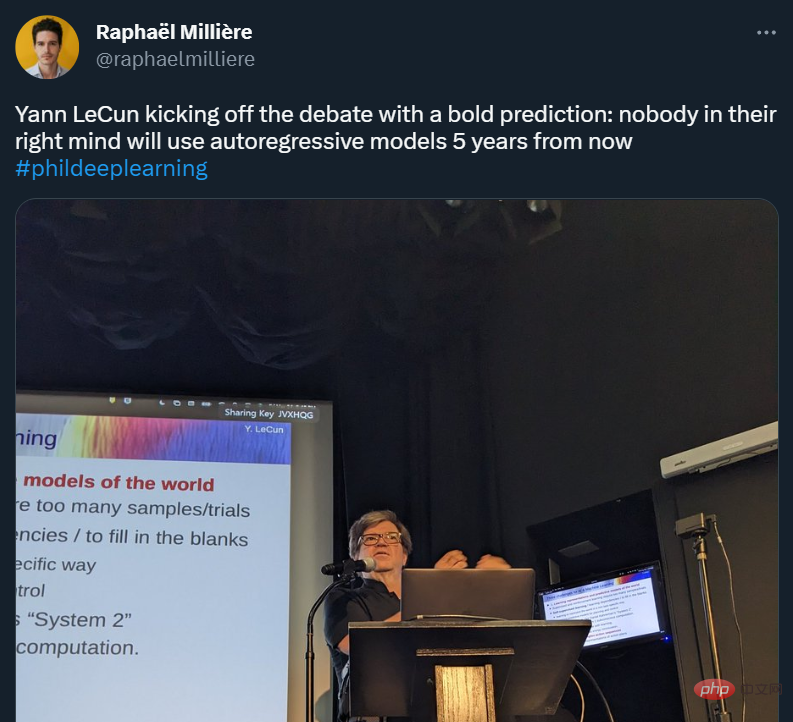 Technology peripherals
Technology peripherals AI
AI Use AI to help hundreds of millions of blind people 'see the world' again!
Use AI to help hundreds of millions of blind people 'see the world' again!In the past, restoring sight to blind people was often regarded as a medical "miracle."
With the explosive breakthrough of multi-modal intelligence technology represented by "machine vision natural language understanding", AI has brought new possibilities to assist blindness, and more blindness Users will use the perception, understanding and interaction capabilities provided by AI to "see the world" again in another way.
AI helps the blind, allowing more people to "see the world" again
Generally speaking, visually impaired people who cannot see with their eyes The channel through which patients perceive the outside world is through other senses besides vision, such as hearing, smell, and touch. Information from these other modalities helps the visually impaired alleviate the problems caused by vision defects to a certain extent. However, scientific research shows that among the external information humans obtain, vision accounts for as much as 70% to 80%.
Therefore, building a machine vision system based on AI to help visually impaired patients have visual perception and visual understanding of the external environment is undoubtedly the most direct and effective solution.
In the field of visual perception, current single-modal AI models have surpassed human levels in image recognition tasks, but this type of technology can currently only achieve recognition and recognition within the visual modality. Understanding, it is difficult to complete cross-modal learning, understanding and reasoning that intersects with other sensory information. To put it simply, it can only be perceived but not understood.
To this end, David Marr, one of the founders of computational vision, proposed the core issue of visual understanding research in the book "Vision", believing that the visual system should be constructed in two dimensions of the environment. or three-dimensional representation and can be interacted with. Interaction here means learning, understanding and reasoning.
It can be seen that excellent AI blindness assistance technology is actually a systematic project that includes intelligent sensing, intelligent user intention reasoning and intelligent information presentation. Only in this way can information accessibility be built interactive interface.
In order to improve the generalization ability of the AI model and enable the machine to have cross-modal image analysis and understanding capabilities, multi-modal algorithms represented by "machine vision natural language understanding" began rise and develop rapidly.
This algorithm model for the interaction of multiple information modalities can significantly improve AI’s perception, understanding and interaction capabilities. Once mature and applied to the field of AI blindness assistance, it will benefit the digital world. Hundreds of millions of blind people can "see the world" again.
According to WHO statistics, at least 2.2 billion people in the world are visually impaired or blind, and my country is the country with the most blind people in the world, accounting for 18%-20% of the total number of blind people in the world. The number of newly blind people reaches 450,000 every year.
The "domino effect" caused by the visual question and answer task for the blind
First-person perspective perception technology is of great significance to AI for assisting the blind. It does not require blind people to step out as participants to operate smart devices. Instead, it can start from the blind person's real perspective and help scientists build algorithm models that are more in line with blind people's cognition. This has prompted the emergence of the basic research task of visual question answering for blind people.
The visual question and answer task for blind people is the starting point and one of the core research directions for academic research on AI assistance for blindness. However, under the current technical conditions, the blind visual question and answer task, as a special type of visual question and answer task, faces greater difficulties in improving accuracy compared with ordinary visual question and answer tasks.
On the one hand, the types of questions for blind visual question and answer are more complex, including target detection, text recognition, color, attribute recognition and other types of problems, such as distinguishing meat in the refrigerator, consulting Instructions for taking medicines, choosing unique colored shirts, introducing book contents, etc.
On the other hand, due to the particularity of the blind person as a perceptual interaction subject, it is difficult for the blind person to grasp the distance between the mobile phone and the object when taking pictures, which often results in out-of-focus situations. Or although the object is captured, not all of it is captured, or key information is not captured, which greatly increases the difficulty of effective feature extraction.
At the same time, most of the existing visual question and answer models are based on question and answer data training in a closed environment. They are severely limited by sample distribution and are difficult to generalize to question and answer scenarios in the open world. , it is necessary to integrate external knowledge for multi-stage reasoning.

Blind visual question and answer data
##Secondly, with the development of blind visual question and answer research, scientists During the research process, it was discovered that visual question answering will encounter derivative problems caused by noise interference. Therefore, how to accurately locate noise and complete intelligent reasoning also faces major challenges.
Blind people often make a large number of errors in visual question-and-answer tasks involving image-text pairing because they do not have visual perception of the outside world. For example, when a blind person goes shopping in a supermarket, it is easy for a blind person to ask the wrong questions due to the similar appearance and feel of the products, such as picking up a bottle of vinegar and asking who the manufacturer of soy sauce is. This kind of language noise often causes existing AI models to fail, requiring AI to have the ability to analyze noise and available information from complex environments.
Finally, the AI assisted blind system should not only answer the current doubts of the blind, but also have the ability to reason about intelligent intentions and present intelligent information, and intelligent interaction technology is an important research direction. Algorithm research is still in its infancy.
The research focus of intelligent intent reasoning technology is to infer that visually impaired users want to express their interactive intentions by allowing the machine to continuously learn the language and behavioral habits of visually impaired users. For example, through the action of a blind person holding a water glass and sitting down, it can predict the next action of placing the water glass on the table, and through the blind person asking questions about the color or style of clothes, it can predict possible travel, etc.
The difficulty of this technology is that due to the randomness of the user's expression and expression actions in time and space, the psychological model of interactive decision-making also brings There is randomness, so how to extract effective information input by users from continuous random behavioral data and design a dynamic non-deterministic multi-modal model to achieve the best presentation of different tasks is very critical.
Focus on basic research on AI to assist blindness, Inspur Information has won international recognition for many of its studiesThere is no doubt that AI is the major breakthrough in the above basic research fields. The key to early implementation of technology to assist blindness. Currently, the cutting-edge research team from Inspur Information is making every effort to promote the further development of AI blindness assistance research through multiple algorithm innovations, pre-training models and basic data set construction.
In the field of blind visual question and answer task research, VizWiz-VQA is a global multi-modal top blind visual question and answer challenge jointly launched by scholars from Carnegie Mellon University and other institutions. It adopts The "VizWiz" blind vision data set trains the AI model, and then the AI gives answers to random picture and text pairs provided by the blind people. In the visual question and answer task for the blind, Inspur Information Frontier Research Team solved many common problems in the visual question and answer task for the blind.
First of all, since the pictures taken by the blind are blurry and have less effective information, the questions are usually more subjective and vague, and it is a challenge to understand the appeals of the blind and give answers. sex.
The team proposed a dual-stream multi-modal anchor point alignment model, which uses key entities and attributes of visual target detection as anchor points to connect pictures and questions to achieve multi-modal semantic enhancement.
Secondly, in view of the problem that it is difficult for blind people to ensure the correct direction when taking pictures, by automatically correcting the image angle and character semantic enhancement, combined with optical character detection and recognition technology to solve the problem of "is "What" is a question of understanding.
Finally, the pictures taken by blind people are usually blurry and incomplete, which makes it difficult for general algorithms to determine the type and purpose of the target object, and the model needs to be more capable. Sufficient common sense ability to reason about the user's true intentions.
To this end, the team proposed an algorithm that combines answer-driven visual positioning with large model image and text matching, and proposed a multi-stage cross-training strategy. During reasoning, the cross-trained visual positioning and image-text matching models are used to infer and locate the answer area; at the same time, the regional characters are determined based on the optical character recognition algorithm, and the output text is sent to the text encoder, and finally the text of the image-text matching model is The decoder got the answer that the blind man asked for help, and the final accuracy of the multi-modal algorithm was 9.5 percentage points ahead of human performance.

Multi-modal visual question answering model solution
One of the biggest obstacles to the current application of visual positioning research is the intelligent processing of noise. In real scenes, text descriptions are often noisy. , such as human slips of the tongue, ambiguity, rhetoric, etc. Experiments have found that text noise can cause existing AI models to fail.
To this end, Inspur Information Frontier Research Team explored the multi-modal mismatch problem caused by human language errors in the real world, and proposed the visual positioning text denoising reasoning task FREC for the first time. The model is required to correctly locate the visual content corresponding to the noise description and further reason about the evidence that the text is noisy.
FREC provides 30,000 images and more than 250,000 text annotations, covering a variety of noises such as slips of the tongue, ambiguity, subjective deviations, etc. It also provides interpretable noise correction, noisy evidence, etc. Label.

##FCTR structure diagram
At the same time, the team also built the first The interpretable denoising visual positioning model FCTR improves the accuracy by 11 percentage points compared with the traditional model under noisy text description conditions.
This research result has been published at the ACM Multimedia 2022 conference, which is the top conference in the international multimedia field and the only CCF-recommended Class A international conference in this field.

##Paper address: https://www.php.cn/link/9f03268e82461f179f372e61621f42d9
In order to explore AI’s ability to interact with thoughts based on images and text, Inspur Information Frontier Research Team has proposed a new research direction for the industry, proposing the explainable agent visual interaction question and answer task AI-VQA, through Establish logical links to search in a huge knowledge base, and expand existing content of images and texts.Currently, the team has built an open source data set for AI-VQA, which contains more than 144,000 large-scale event knowledge bases, 19,000 interactive behavior cognitive reasoning questions fully manually annotated, and key Interpretable annotations such as objects, supporting facts, and reasoning paths.

ARE structure diagram
At the same time, the first smart phone proposed by the team The body interaction behavior understanding algorithm model ARE (encoder-decoder model for alternative reason and explanation) realizes end-to-end interaction behavior positioning and interaction behavior impact reasoning for the first time. Based on multi-modal image and text fusion technology and knowledge graph retrieval algorithm, it realizes long-term A visual question answering model for causal chain reasoning ability.The greatness of technology is not only to change the world, but more importantly, how to benefit mankind and make more impossible things possible.
For the blind, being able to live independently like other people through AI technology to assist the blind, rather than being treated specially, reflects the greatest goodwill of technology.
Now that AI is shining into reality, technology is no longer as cold as a mountain, but full of the warmth of humanistic care.
Standing at the forefront of AI technology, Inspur Information hopes that research on artificial intelligence technology can attract more people to continue to promote the implementation of artificial intelligence technology, so that multi-modal AI can help The wave of blindness extends to more scenarios such as AI anti-fraud, AI diagnosis and treatment, AI disaster early warning, etc., creating more value for our society.
Reference link: ##https://www.php.cn/link/9f03268e82461f179f372e61621f42d9
The above is the detailed content of Use AI to help hundreds of millions of blind people 'see the world' again!. For more information, please follow other related articles on the PHP Chinese website!
 ai合并图层的快捷键是什么Jan 07, 2021 am 10:59 AM
ai合并图层的快捷键是什么Jan 07, 2021 am 10:59 AMai合并图层的快捷键是“Ctrl+Shift+E”,它的作用是把目前所有处在显示状态的图层合并,在隐藏状态的图层则不作变动。也可以选中要合并的图层,在菜单栏中依次点击“窗口”-“路径查找器”,点击“合并”按钮。
 ai橡皮擦擦不掉东西怎么办Jan 13, 2021 am 10:23 AM
ai橡皮擦擦不掉东西怎么办Jan 13, 2021 am 10:23 AMai橡皮擦擦不掉东西是因为AI是矢量图软件,用橡皮擦不能擦位图的,其解决办法就是用蒙板工具以及钢笔勾好路径再建立蒙板即可实现擦掉东西。
 谷歌超强AI超算碾压英伟达A100!TPU v4性能提升10倍,细节首次公开Apr 07, 2023 pm 02:54 PM
谷歌超强AI超算碾压英伟达A100!TPU v4性能提升10倍,细节首次公开Apr 07, 2023 pm 02:54 PM虽然谷歌早在2020年,就在自家的数据中心上部署了当时最强的AI芯片——TPU v4。但直到今年的4月4日,谷歌才首次公布了这台AI超算的技术细节。论文地址:https://arxiv.org/abs/2304.01433相比于TPU v3,TPU v4的性能要高出2.1倍,而在整合4096个芯片之后,超算的性能更是提升了10倍。另外,谷歌还声称,自家芯片要比英伟达A100更快、更节能。与A100对打,速度快1.7倍论文中,谷歌表示,对于规模相当的系统,TPU v4可以提供比英伟达A100强1.
 ai可以转成psd格式吗Feb 22, 2023 pm 05:56 PM
ai可以转成psd格式吗Feb 22, 2023 pm 05:56 PMai可以转成psd格式。转换方法:1、打开Adobe Illustrator软件,依次点击顶部菜单栏的“文件”-“打开”,选择所需的ai文件;2、点击右侧功能面板中的“图层”,点击三杠图标,在弹出的选项中选择“释放到图层(顺序)”;3、依次点击顶部菜单栏的“文件”-“导出”-“导出为”;4、在弹出的“导出”对话框中,将“保存类型”设置为“PSD格式”,点击“导出”即可;
 ai顶部属性栏不见了怎么办Feb 22, 2023 pm 05:27 PM
ai顶部属性栏不见了怎么办Feb 22, 2023 pm 05:27 PMai顶部属性栏不见了的解决办法:1、开启Ai新建画布,进入绘图页面;2、在Ai顶部菜单栏中点击“窗口”;3、在系统弹出的窗口菜单页面中点击“控制”,然后开启“控制”窗口即可显示出属性栏。
 GPT-4的研究路径没有前途?Yann LeCun给自回归判了死刑Apr 04, 2023 am 11:55 AM
GPT-4的研究路径没有前途?Yann LeCun给自回归判了死刑Apr 04, 2023 am 11:55 AMYann LeCun 这个观点的确有些大胆。 「从现在起 5 年内,没有哪个头脑正常的人会使用自回归模型。」最近,图灵奖得主 Yann LeCun 给一场辩论做了个特别的开场。而他口中的自回归,正是当前爆红的 GPT 家族模型所依赖的学习范式。当然,被 Yann LeCun 指出问题的不只是自回归模型。在他看来,当前整个的机器学习领域都面临巨大挑战。这场辩论的主题为「Do large language models need sensory grounding for meaning and u
 强化学习再登Nature封面,自动驾驶安全验证新范式大幅减少测试里程Mar 31, 2023 pm 10:38 PM
强化学习再登Nature封面,自动驾驶安全验证新范式大幅减少测试里程Mar 31, 2023 pm 10:38 PM引入密集强化学习,用 AI 验证 AI。 自动驾驶汽车 (AV) 技术的快速发展,使得我们正处于交通革命的风口浪尖,其规模是自一个世纪前汽车问世以来从未见过的。自动驾驶技术具有显着提高交通安全性、机动性和可持续性的潜力,因此引起了工业界、政府机构、专业组织和学术机构的共同关注。过去 20 年里,自动驾驶汽车的发展取得了长足的进步,尤其是随着深度学习的出现更是如此。到 2015 年,开始有公司宣布他们将在 2020 之前量产 AV。不过到目前为止,并且没有 level 4 级别的 AV 可以在市场
 ai移动不了东西了怎么办Mar 07, 2023 am 10:03 AM
ai移动不了东西了怎么办Mar 07, 2023 am 10:03 AMai移动不了东西的解决办法:1、打开ai软件,打开空白文档;2、选择矩形工具,在文档中绘制矩形;3、点击选择工具,移动文档中的矩形;4、点击图层按钮,弹出图层面板对话框,解锁图层;5、点击选择工具,移动矩形即可。


Hot AI Tools

Undresser.AI Undress
AI-powered app for creating realistic nude photos

AI Clothes Remover
Online AI tool for removing clothes from photos.

Undress AI Tool
Undress images for free

Clothoff.io
AI clothes remover

AI Hentai Generator
Generate AI Hentai for free.

Hot Article

Hot Tools

EditPlus Chinese cracked version
Small size, syntax highlighting, does not support code prompt function

Safe Exam Browser
Safe Exam Browser is a secure browser environment for taking online exams securely. This software turns any computer into a secure workstation. It controls access to any utility and prevents students from using unauthorized resources.

Dreamweaver CS6
Visual web development tools

SublimeText3 Linux new version
SublimeText3 Linux latest version

mPDF
mPDF is a PHP library that can generate PDF files from UTF-8 encoded HTML. The original author, Ian Back, wrote mPDF to output PDF files "on the fly" from his website and handle different languages. It is slower than original scripts like HTML2FPDF and produces larger files when using Unicode fonts, but supports CSS styles etc. and has a lot of enhancements. Supports almost all languages, including RTL (Arabic and Hebrew) and CJK (Chinese, Japanese and Korean). Supports nested block-level elements (such as P, DIV),






